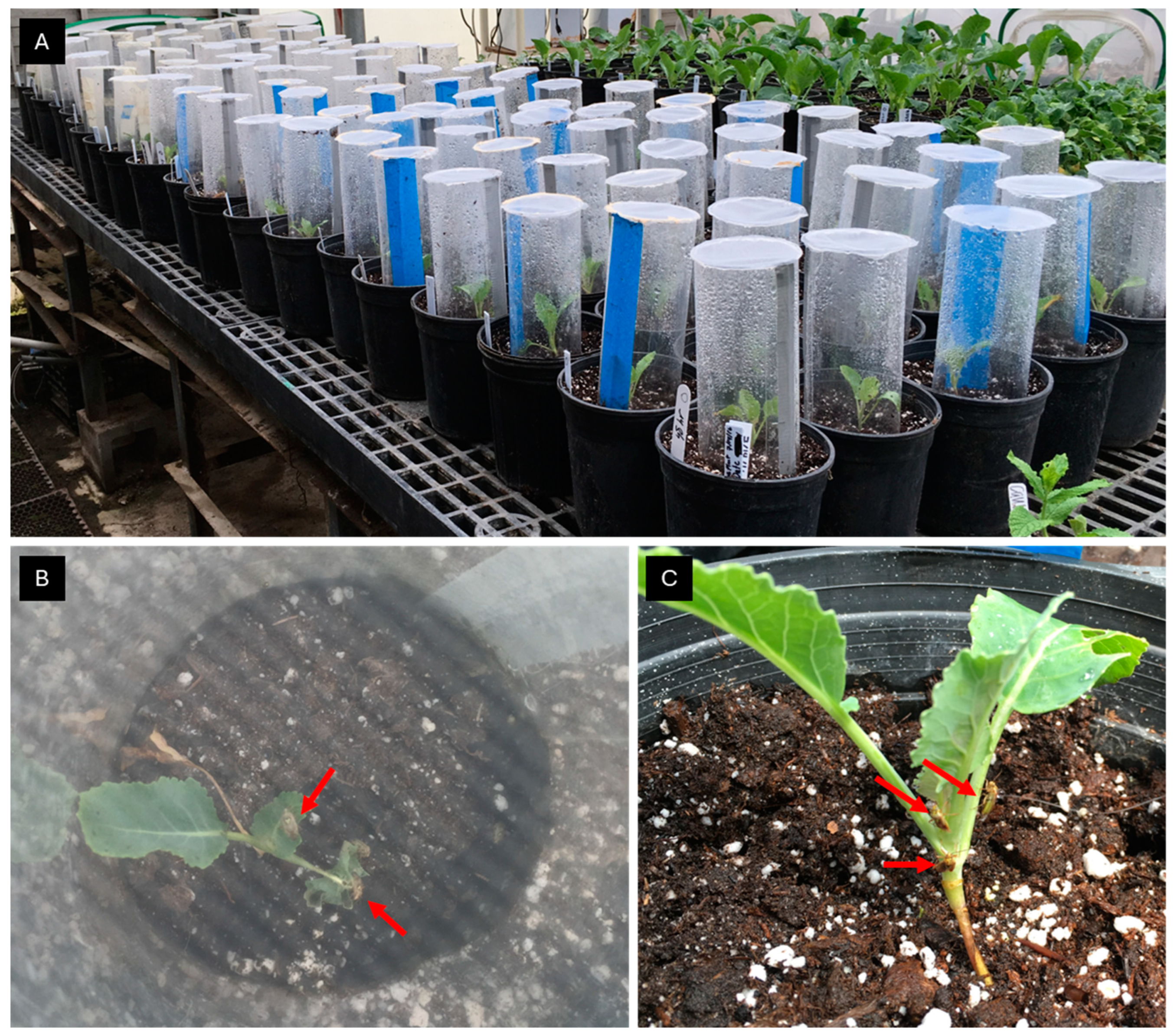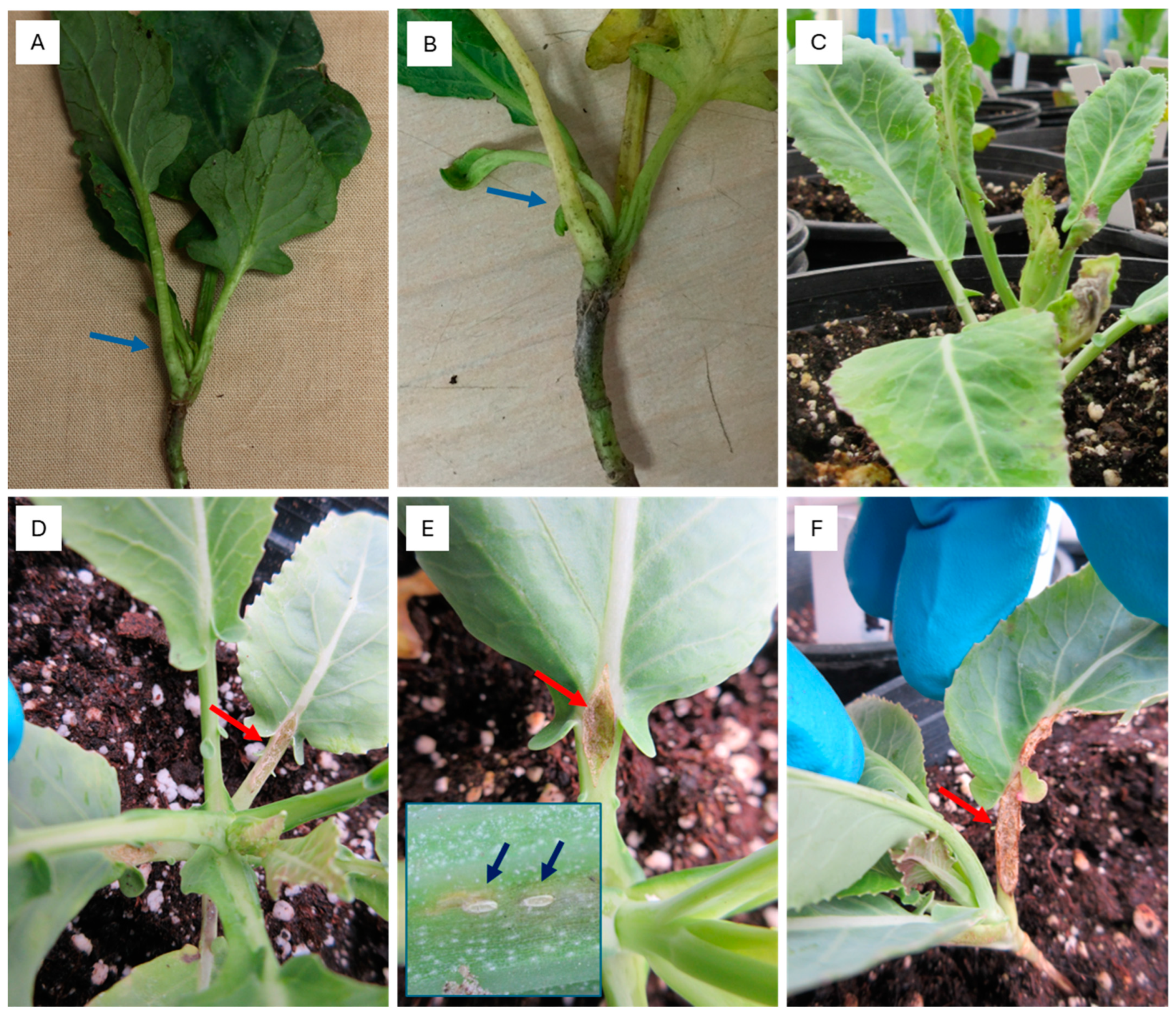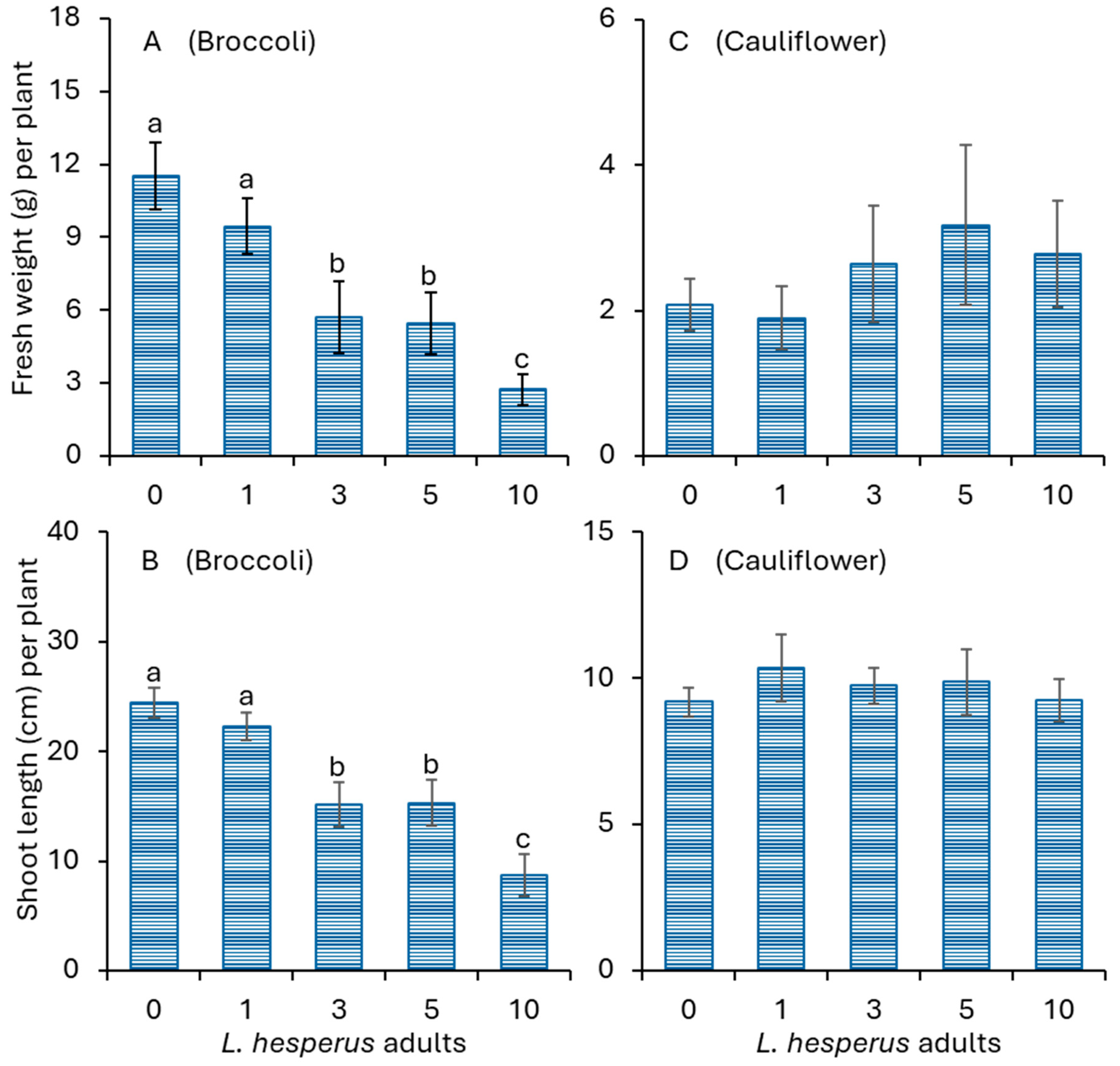Injury Caused by Western Tarnished Plant Bug (Hemiptera: Miridae) on Broccoli and Cauliflower in Laboratory Assays
Abstract
1. Introduction
2. Materials and Methods
2.1. Plant and Insect
2.2. Cage Design and Experiment Design
2.3. Evaluation
2.4. Statistical Analyses
3. Results
3.1. Feeding Injury
3.2. Ovipositional Injury
3.2.1. Broccoli
3.2.2. Cauliflower
4. Discussion
Funding
Data Availability Statement
Acknowledgments
Conflicts of Interest
References
- Natwick, E.T.; Joseph, S.V.; Dara, S.K. UC IPM Pest Management Guidelines: Lettuce, Lygus Bug. 2017. UC ANR Publication 3450. Available online: https://ipm.ucanr.edu/agriculture/lettuce/lygus-bug-western-tarnished-plant-bug/#gsc.tab=0 (accessed on 13 February 2025).
- Zalom, F.G.; Bolda, M.P.; Dara, S.K.; Joseph, S.V. Strawberry: Lygus Bug. UC Pest Management Guidelines, 2018, UC ANR Publication 3468. Available online: https://ipm.ucanr.edu/agriculture/strawberry/lygus-bug/#gsc.tab=0 (accessed on 13 February 2025).
- Fye, R.E. Damage to vegetable and forage seedlings by overwintering Lygus hesperus (Heteroptera: Miridae) adults. J. Econ. Entomol. 1984, 77, 1141–1143. [Google Scholar] [CrossRef]
- 4. [MCCR] Monterey County Crop Report, 2021. 2022. Office of Agricultural Commissioner-Monterey County, California. Available online: https://www.co.monterey.ca.us/home/showpublisheddocument/113214 (accessed on 13 February 2025).
- [SBCCR] San Benito County Crop Report, 2021. 2022a, Office of Agricultural Commissioner-San Benito County, California. Available online: https://www.sanbenitocountyca.gov/home/showpublisheddocument/9289/638013491788500000 (accessed on 13 February 2025).
- [SBCCR] Santa Barbara County Crop Report, 2021. 2022b, Office of Agricultural Commissioner-Santa Barbara County, California. Available online: https://content.civicplus.com/api/assets/d84d16ed-052c-4c6d-a329-e676ef39ead7 (accessed on 13 February 2025).
- [SLOCCR] San Luis Obispo County Crop Report, 2021. 2022, Office of Agricultural Commissioner-San Luis Obispo County, California. Available online: https://www.slocounty.ca.gov/departments/agriculture-weights-and-measures/department-news/2021-annual-crop-statistics-released (accessed on 13 February 2025).
- [SCCCR] Santa Cruz County Crop Report, 2021. 2022, Office of Agricultural Commissioner-Santa Cruz County, California. Available online: https://www.agdept.com/Portals/10/pdf/Final%20Online%20-%202021%20Crop%20Report.pdf?ver=l87OElCLz3q_RcQe8X6GZw%3d%3d (accessed on 13 February 2025).
- Hill, L.L. Protection of celery from tarnished plant bug injury. J. Econ. Entomol. 1932, 25, 671–678. [Google Scholar] [CrossRef]
- Hill, L.L. Further studies of tarnished plant bug injury to celery. J. Econ. Entomol. 1933, 26, 148–150. [Google Scholar] [CrossRef]
- Joseph, S.V.; Ahedo, R.; de la Fuente, M. Characterization of Lygus hesperus (Hemiptera: Miridae) feeding and oviposition injury on celery seedlings. Plant Health Prog. 2016, 17, 101–105. [Google Scholar] [CrossRef]
- Joseph, S.V. Impact of Lygus hesperus (Hemiptera: Miridae) feeding and oviposition injury on lettuce. Plant Health Prog. 2019, 20, 215–219. [Google Scholar] [CrossRef]
- Mauney, J.R.; Henneberry, T.J. Identification of damage symptoms and patterns of feeding of plant bugs in cotton. J. Econ. Entomol. 1979, 72, 496–501. [Google Scholar] [CrossRef]
- Strong, F.E. Physiology of injury caused by Lygus hesperus. J. Econ. Entomol. 1970, 63, 808–814. [Google Scholar] [CrossRef]
- Miles, P.W. The saliva of Hemiptera. Adv. Insect Physiol. 1972, 9, 183–255. [Google Scholar]
- Backus, E.A.; Serrano, M.S.; Ranger, C.M. Mechanisms of hopperburn: An overview of insect taxonomy, behavior, and physiology. Ann. Rev. Entomol. 2005, 50, 125–151. [Google Scholar] [CrossRef] [PubMed]
- SAS Institute. SAS, Version 9.4; SAS Institute: Cary, NC, USA, 2024. [Google Scholar]
- Scott, D.R. Feeding of Lygus bugs (Hemiptera: Miridae) on developing carrot and bean seed: Increased growth and yields of plants grown from that seed. Ann. Entomol. Soc. Am. 1970, 63, 1604–1608. [Google Scholar] [CrossRef]
- Snodgrass, G.L. Distribution of the tarnished plant bug (Heteroptera: Miridae) within cotton plants. Environ. Entomol. 1988, 27, 1089–1093. [Google Scholar] [CrossRef]
- Alvarado-Rodriguez, B.; Leigh, T.F.; Foster, K.W. Oviposition site preference of Lygus hesperus (Hemiptera: Miridae) on common bean in relation to bean age and genotype. J. Econ. Entomol. 1986, 79, 1069–1072. [Google Scholar] [CrossRef]
- Barlow, V.M.; Godfrey, L.D.; Norris, R.F. Population dynamics of Lygus hesperus (Heteroptera: Miridae) on selected weeds in comparison with alfalfa. J. Econ. Entomol. 1999, 92, 846–852. [Google Scholar] [CrossRef]
- Hillock, D. Growing Broccoli, Caulifiower and Cabbage. 2016, Oklahoma State Extension, HLA-6017. Available online: https://extension.okstate.edu/fact-sheets/growing-broccoli-caulifiower-and-cabbage.html (accessed on 13 February 2025).
- Koike, S.T.; Cahn, M.; Cantwell, M.; Fennimore, S.; Lestrange, M.; Natwick, E.; Smith, R.F.; Takele, E. Cauliflower production in California. Agric. Nat. Resour. 2009, 7219. [Google Scholar] [CrossRef]





| Treatment | Egg | Lesion | ||||
|---|---|---|---|---|---|---|
| F | df | p | F | df | p | |
| Broccoli | ||||||
| L. hesperus | 143.4 | 4126 | <0.001 | 29.9 | 4126 | <0.001 |
| Exposure time | 11.9 | 2126 | <0.001 | 3.9 | 2126 | 0.023 |
| L. hesperus × Exposure time | 10.4 | 8126 | <0.001 | 2.7 | 8126 | 0.010 |
| Cauliflower | ||||||
| L. hesperus | 77.5 | 4117 | <0.001 | 25.2 | 4126 | <0.001 |
| Exposure time | 23.7 | 2117 | <0.001 | 4.2 | 2126 | 0.018 |
| L. hesperus × Exposure time | 28.7 | 7117 | <0.001 | 2.4 | 8126 | 0.017 |
Disclaimer/Publisher’s Note: The statements, opinions and data contained in all publications are solely those of the individual author(s) and contributor(s) and not of MDPI and/or the editor(s). MDPI and/or the editor(s) disclaim responsibility for any injury to people or property resulting from any ideas, methods, instructions or products referred to in the content. |
© 2025 by the author. Licensee MDPI, Basel, Switzerland. This article is an open access article distributed under the terms and conditions of the Creative Commons Attribution (CC BY) license (https://creativecommons.org/licenses/by/4.0/).
Share and Cite
Joseph, S.V. Injury Caused by Western Tarnished Plant Bug (Hemiptera: Miridae) on Broccoli and Cauliflower in Laboratory Assays. Horticulturae 2025, 11, 210. https://doi.org/10.3390/horticulturae11020210
Joseph SV. Injury Caused by Western Tarnished Plant Bug (Hemiptera: Miridae) on Broccoli and Cauliflower in Laboratory Assays. Horticulturae. 2025; 11(2):210. https://doi.org/10.3390/horticulturae11020210
Chicago/Turabian StyleJoseph, Shimat V. 2025. "Injury Caused by Western Tarnished Plant Bug (Hemiptera: Miridae) on Broccoli and Cauliflower in Laboratory Assays" Horticulturae 11, no. 2: 210. https://doi.org/10.3390/horticulturae11020210
APA StyleJoseph, S. V. (2025). Injury Caused by Western Tarnished Plant Bug (Hemiptera: Miridae) on Broccoli and Cauliflower in Laboratory Assays. Horticulturae, 11(2), 210. https://doi.org/10.3390/horticulturae11020210







